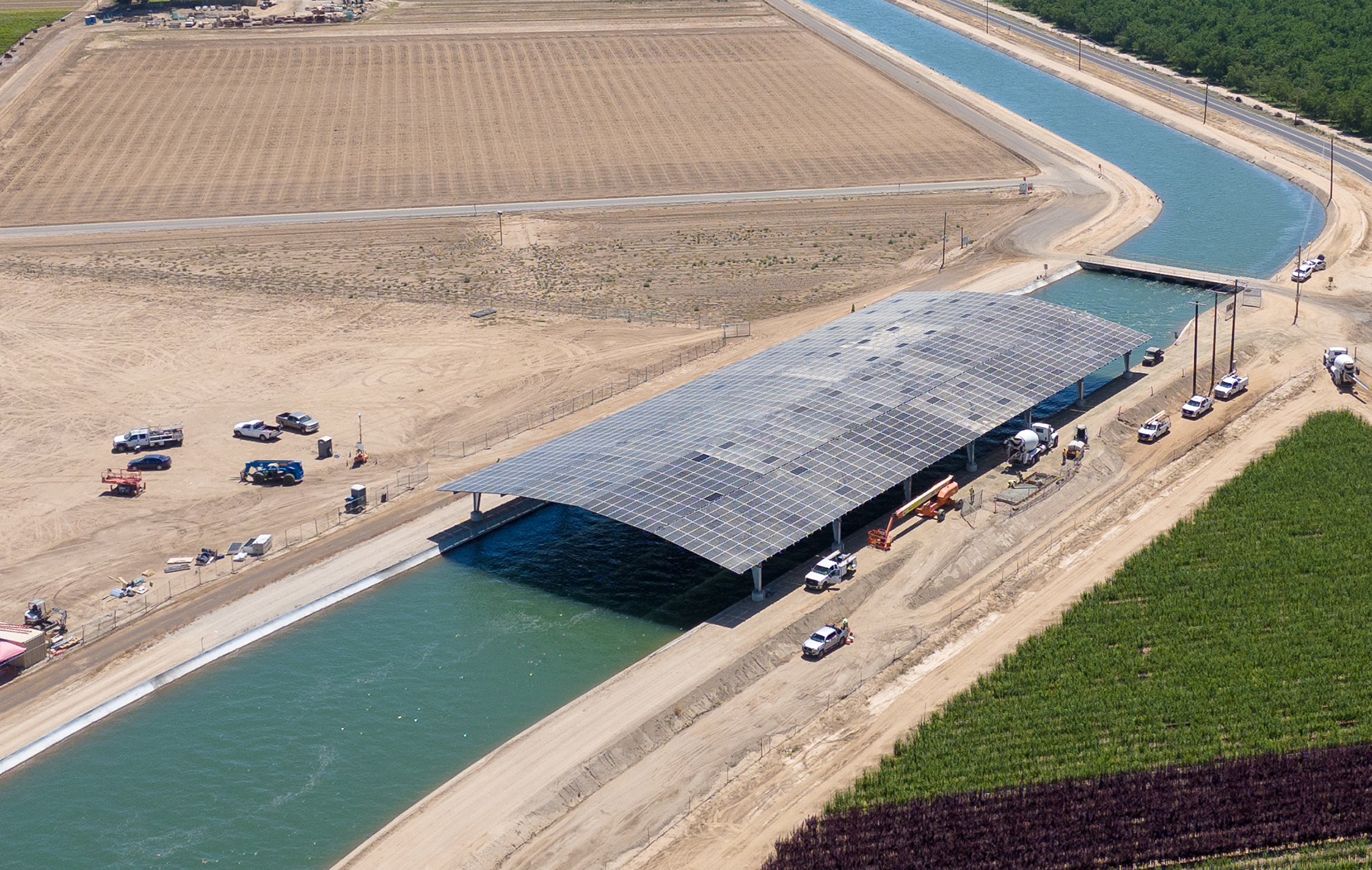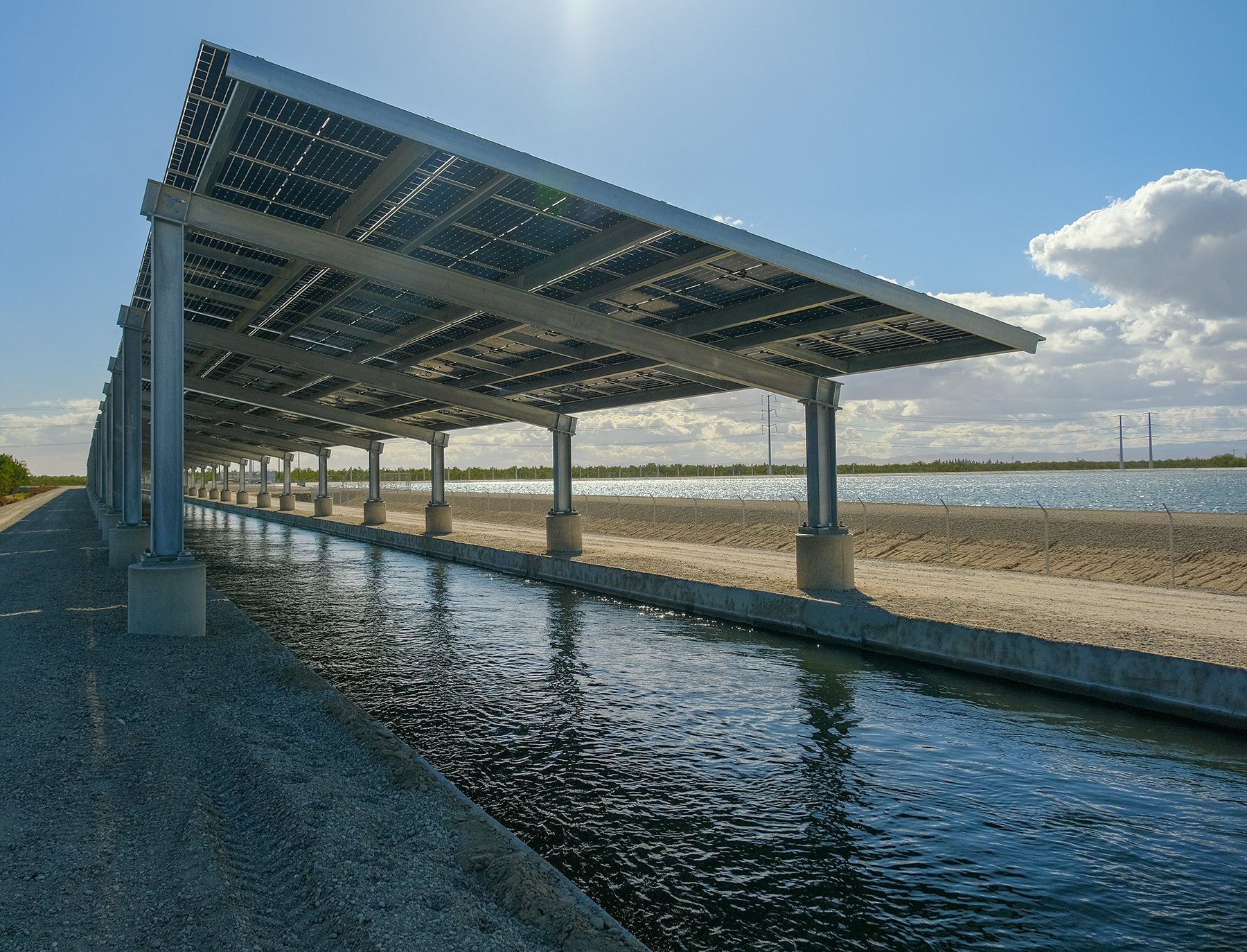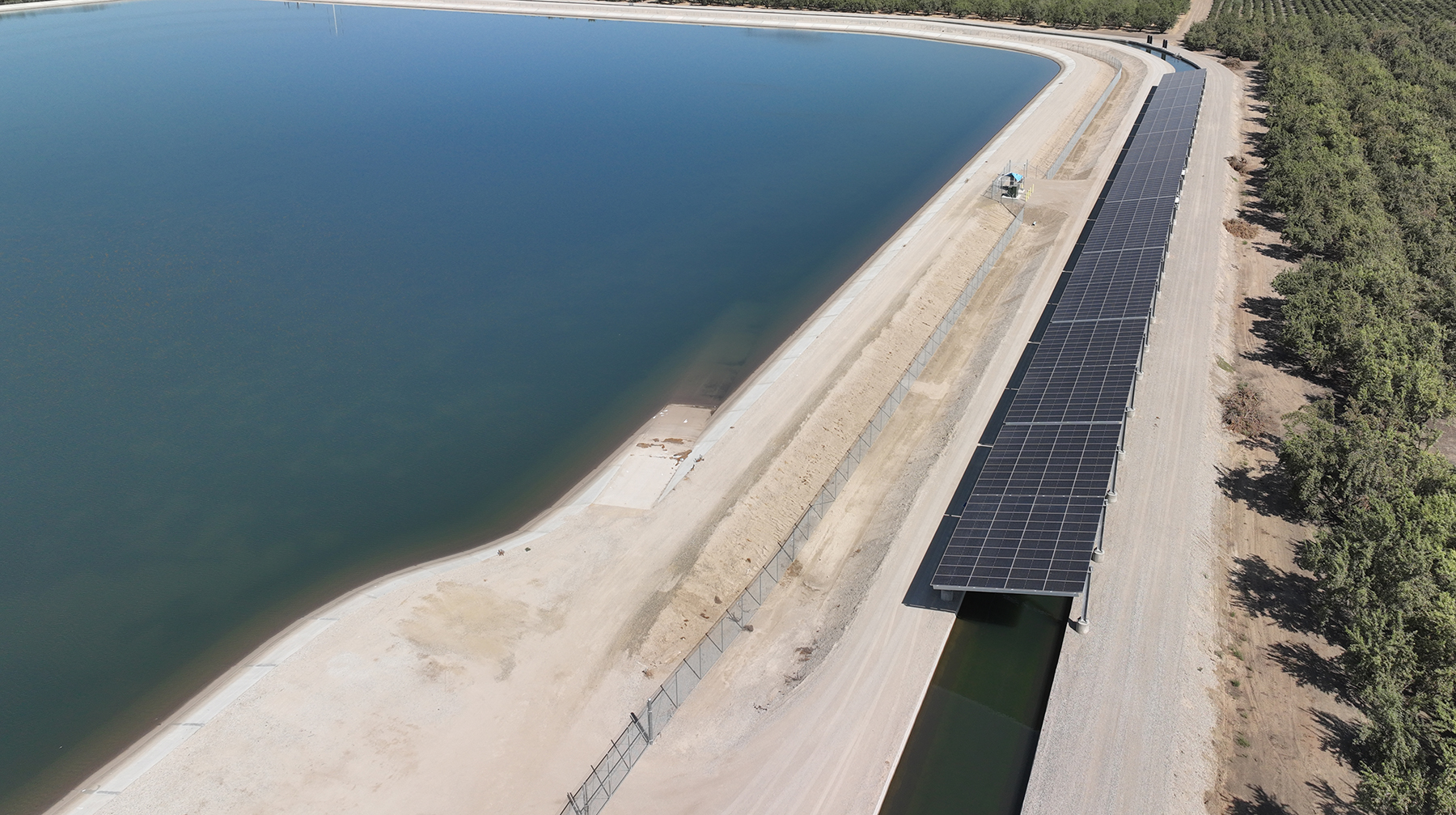 Turlock Irrigation District
Turlock Irrigation District A peaked structure supports the solar panels above a 300-foot-long section of wide-span canal, 115 feet across.
An irrigation district in California’s Central Valley region has installed arrays of solar panels atop a series of canals to demonstrate how such systems can generate electrical power and, through shading, reduce the loss of water from evaporation.
The solar arrays are also intended to reduce maintenance costs on the canals by limiting the amount of vegetation that forms in the canals and hampers water flow, explained Bill Penney, P.E., civil engineering department manager at the Turlock Irrigation District.
Further reading
- Solar ‘armadillo’ to power up in Taiwan
- Solar panels atop highways could redefine the word ‘sunroof’
- The renewable energy source right beneath our feet
Founded in 1887 as California’s first publicly owned irrigation district, the TID helped bring water to the “dry land nestled between the Tuolumne, Merced, and San Joaquin rivers,” according to the district’s website. In the 1920s, the TID also began to generate electricity for its customers, first through a hydropower dam but now also via natural gas facilities as well as wind and solar generation, noted Penney. The canal solar arrays project is just the latest innovative concept to be tried in the TID’s nearly 140-year history, Penney said.
Dubbed Project Nexus, the canal solar arrays are intended to serve as a proof of concept “to pilot and further study solar over canal design, deployment, and co-benefits on behalf of the state of California using TID infrastructure and electrical grid access,” according to a Nexus fact sheet. The project arose from a 2021 study conducted by the University of California, Merced that predicted “significant water, energy, and cost savings for the state” if solar panels covered all of California’s approximately 4,000 miles of public water delivery system infrastructure, according to the fact sheet.
For Project Nexus, solar panels were installed above two narrow-span canals, each 25 feet wide, covering a total distance of 1,400 linear feet; solar panels were also installed over a 300-foot-long section of a wide-span canal, measuring 115 feet across. Most of the canals in TID’s roughly 250-mile-long canal system are narrow span, Penney added, but one of the district’s wide-span conveyances was included in the pilot because California’s Department of Water Resources administered the funding from the state for Project Nexus.
The DWR operates and maintains the California aqueduct system, which features canals that can measure more than 100 feet wide, Penney explained.
In addition to the TID and the DWR, Project Nexus also involved UC Merced and Solar AquaGrid, a Bay Area development firm that commissioned the UC Merced study and served as program manager for the canal solar array effort. Machado & Sons, based in Turlock, California, was the project’s general contractor. San Jose, California-based MBL Energy was the structural engineer and contractor. Blymyer Engineers, of Alameda, California, was responsible for electrical engineering. BEI Construction, also in Alameda, headed up the electrical construction.
Rural settings
The arrays above the two narrow-span canals were installed in April at sites near a relatively new irrigation regulating reservoir that itself had been completed in August 2023, said Penney. The wide-span array was installed in September at a site roughly 10 miles from the narrow-span arrays.
 Turlock Irrigation District
Turlock Irrigation DistrictThe TID has canals in urban settings and rural settings. It chose rural locations for the Nexus sites, in part, to avoid potential issues such as solar glare from the photovoltaics bothering people in more heavily populated neighborhoods, Penney said. At the same time, the district sought locations that were easily accessed and not too remote because the project would likely attract media attention, he added.
The structures for the solar arrays featured steel-framed supports made from I-beams with foundations made with recycled concrete and recycled rebar. At the sites, the solar arrays had to be at least tall enough for a person – or equipment – to pass underneath the array, permitting a worker to access the canal, perform maintenance activities, or conduct canal operations, Penney said.
The narrow canal arrays were constructed in a slanting configuration for optimal solar exposure, the low side providing a minimum of 8 feet of clearance under the array and the high side reaching a minimum of 14 feet. The wide-span array featured an arched or peaked design, supported on seven I-beam trusses that span the canal, with a 14-foot clearance on each side.
Because the solar array foundations encroached on the canal access roads by anywhere from 2 to 5 feet in places, the banks of the canals were widened in certain locations, extending into the surrounding farmland – but always within the TID’s right of way, Penney said. The foundations extend into the ground between 15 and 18 feet deep – several feet deeper than the structures actually need, he explained, but deep enough to keep the arrays standing even if the surrounding bank is washed away.
Generating power
In a March 2022 article on ASCE’s Civil Engineering Source news website, a TID official predicted that the solar array project might generate as much as 5 megawatts of electrical power annually. But that was based on the expectation of a larger pilot test – installing solar arrays to cover as much as 8,000 linear feet of canals, Penney said. Instead, cost, constructability issues, and other factors led to roughly 1,700 linear feet of solar panels being installed, which can produce approximately 1.6 megawatts of electricity, he explained.
The project also installed two 75-kilowatt iron-flow batteries at the narrow-span arrays to provide electricity for the hydraulic pumps at the regulating reservoir, especially at night when the arrays will not be generating power. The reservoir is designed to improve TID operations by capturing water that might otherwise spill into local rivers or get lost through various inefficiencies as it moves through the canals.
“This new irrigation regulating reservoir is at the center of our district,” Penney explained, where it can hold the water until there is increased demand downstream – saving potentially 10,000 acre-feet of water annually.
“So putting solar arrays near this facility that saves water, combined with the new renewable energy source, goes to the core of TID’s innovative spirit!” Penney declared. Noting that the district already gets requests for tours of its operations “from all over world,” Penney looks forward to now also being able “to showcase the arrays.”
Collecting data
Although it is “premature to draw any conclusions” about the performance so far of the solar array project, Penney said, “we have been collecting data that initially seems to be supporting” the UC Merced study, especially in terms of co-benefits. The arrays are producing the electrical power expected and “we are seeing reduced levels of evaporation and vegetative growth in the canals,” he explained.
To track and compare the evaporation rates and other information about the areas with and without the arrays, researchers from UC Merced have installed various instruments under the solar panels and in adjacent, uncovered parts of the canals. The basic pilot test will run through next June, Penney noted, but the solar panels will remain in place, generating power for decades, and he hopes that UC Merced’s team will continue collecting data even after the official conclusion of the study.
Penney does not believe it will be practical or cost-effective to cover every foot of every canal in California with solar panels. But in certain locations, especially remote, rural parts of the state, the arrays can provide power and other benefits much more effectively than, say, constructing 50 miles of new transmission lines. A local power source will also help smaller communities during wildfires, when more distant power sources might be shut down, Penney added.
 Turlock Irrigation District
Turlock Irrigation District


